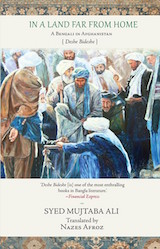 Birth— 1947 Birth— 1947
Where—Bombay
Raised in—India, Pakistan, UK
Education— Cambridge University
Currently—New York
Bibliography
Novels
-
Grimus (1975)
-
Midnight’s Children (1981)
-
Shame (1983)
-
The Satanic Verses (1988)
-
The Moor’s Last Sigh (1995)
-
The Ground Beneath Her Feet (1999)
-
Fury (2001)
-
Shalimar the Clown (2005)
-
The Enchantress of Florence (2008)
-
Two Years Eight Months and Twenty-Eight Nights (2015)
Collections
-
Homeless by Choice (1992, with Ruth Prawar Jhabvala and V. S. Naipaul)
-
East, West (1994)
-
The Best American Short Stories (2008, as Guest Editor)
Children’s Books
-
Haroun and the Sea of Stories (1990)
-
Luka and the Fire of Life (2010)
Essays and Non-fiction
-
The Jaguar Smile: A Nicaraguan Journey (1987)
-
Imaginary Homelands: Essays and Criticism, 1981–1991 (1992)
-
Joseph Anton: A Memoir (2012)
|
Ahmed Salman Rushdie was born on June 19, 1947, in Bombay, India, the only son among Anis Ahmed Rushdie and Negin Butt’s four children. His father was a businessman who had been educated at Cambridge University in England.
Rushdie later attended Cambridge, as his father had done, and his experience there was much more positive. He received his master’s degree in history in 1968. After a brief career as an actor he worked as a free-lance advertising copywriter in England from 1970 to 1980. The experience of expatriation, which he shared with many writers of his generation who were born in the Third World, is an important theme in his work.
First books
Rushdie’s first published book, Grimus (1975), was classified as science fiction by many critics. It is the story of Flapping Eagle, a Native American who is given the gift of immortality (eternal life) and goes on a journey to find the meaning of life. Although the book received positive reviews, it did not sell very well. Rushdie continued working as a part-time ad writer over the five years it took him to write Midnight’s Children. He quit his job after finishing the novel without even knowing if it would be published.
Released first in the United States in 1981, Midnight’s Children is in part the story of a baby who was not only the result of an extramarital affair (an affair between a married person and someone other than his or her spouse) but who was then switched at birth with a second child from a similar situation. The hero is also caught between the two great Indian religions, Islam and Hinduism. Finally, he spends his life moving back and forth between the Indian republic and Pakistan. The book received rave reviews in the United States and was a popular and critical success in England.
Rushdie followed this up with Shame (1983), the story of a Pakistani woman, Sufiya Zinobia, who blushes so hotly with embarrassment at her nation’s history that her body boils her bath water and burns the lips of men who attempt to kiss her.
The Satanic Verses
Rushdie’s fourth novel, The Satanic Verses, encountered a different reception. Some of the adventures in this book depict a character modeled on the Prophet Muhammad and portray both him and his transcription of the Qurʾān in a manner that, after the novel’s publication in the summer of 1988, drew criticism from Muslim community leaders in Britain, who denounced the novel as blasphemous. Public demonstrations against the book spread to Pakistan in January 1989. On February 14 the spiritual leader of revolutionary Iran, Ayatollah Ruhollah Khomeini, publicly condemned the book and issued a fatwā (legal opinion) against Rushdie; a bounty was offered to anyone who would execute him.
Post Fatwa Work
Despite the standing death threat, Rushdie continued to write, producing Imaginary Homelands (1991), a collection of essays and criticism; the children’s novel Haroun and the Sea of Stories (1990); the short-story collection East, West (1994); and the novel The Moor’s Last Sigh (1995). In 1998, after nearly a decade, the Iranian government announced that it would no longer seek to enforce its fatwā against Rushdie. He later recounted his experience in the third-person memoir Joseph Anton (2012); its title refers to an alias he adopted while in seclusion.
Return to public life
Following his return to public life, Rushdie published the novels The Ground Beneath Her Feet (1999) and Fury (2001). Step Across This Line, a collection of essays he wrote between 1992 and 2002 on subjects from the September 11 attacks to The Wizard of Oz, was published in 2002. Rushdie’s subsequent novels include Shalimar the Clown (2005), an examination of terrorism that was set primarily in the disputed Kashmir region of the Indian subcontinent, and The Enchantress of Florence (2008), based on a fictionalized account of the Mughal emperor Akbar. The children’s book Luka and the Fire of Life (2010) centres on the efforts of Luka—younger brother to the protagonist of Haroun and the Sea of Stories—to locate the titular fire and revive his ailing father. Two Years Eight Months and Twenty-Eight Nights (2015) depicts the chaos ensuing from a rent in the fabric separating the world of humans from that of the Arabic mythological figures known as jinn. Reveling in folkloric allusion—the title references The Thousand and One Nights—the novel unfurls a tapestry of connected stories celebrating the human imagination.
The Booker Prize & the Knighthood
Rushdie received the Booker Prize in 1981 for Midnight’s Children. The novel subsequently won the Booker of Bookers (1993) and the Best of the Booker (2008). These special prizes were voted on by the public in honour of the prize’s 25th and 40th anniversaries, respectively.
He was appointed a Knight Bachelor by Queen Elizabeth II for “services to literature” in June 2007. The honour was criticized by the Iranian government and Pakistan’s parliament.
He holds the rank Commandeur in the Ordre des Arts et des Lettres of France. In May 2008 he was elected to the American Academy of Arts and Letters.
 In a Land Far Away from Home: A Bengali in Afghanistan In a Land Far Away from Home: A Bengali in Afghanistan
Syed Mujtaba Ali
In 1927, a tumultuous time for Afghanistan as King Amanullah attempted comprehensive social reforms, an Indian teacher, Syed Mujtaba Ali, came to Kabul. His travelogue, “In A Land Far From Home”, published in India in 1948
|

 Birth— 1947
Birth— 1947 In a Land Far Away from Home: A Bengali in Afghanistan
In a Land Far Away from Home: A Bengali in Afghanistan